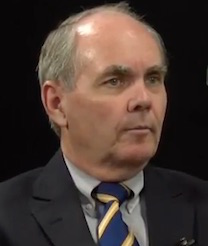By Bill Moore
The summer solstice has arrived, and with it Congressional Quarterly’s “State Rankings 2018.” CQ is a widely-respected, nonpartisan publisher that produces a number of publications, most of which focus on congressional activity.
The report features 566 tables comprised of data collected in 2016. The data reviews 15 “livability” categories: agriculture, crime and law enforcement, defense, economy, education, employment and labor, energy and environment, geography, federal government finances, state and local government finances, health, households and housing, population, social welfare, and transportation.

Bill Moore is president of Central Vermont Chamber of Commerce.
So how does Vermont fare in comparison to the other 49 states and the District of Columbia? The overall rank for the Green Mountain State is sixth, dropping three slots from the 2017 edition.
We rank 43rd for number of farms, at 7,300, representing 0.4 percent of the national total. The average per-acre value of farmland came in at 24th, with a per-acre value of $3,360. Net farm income per operation is $23,256, claiming 22nd place. Nationally, net farm income per acre is $68, while Vermont ranked 10th at $136 income per acre.
On crime ranking, we came in dead last — in this case, a good thing — with 11,537 crimes reported. We ranked 47th for crimes per 100,000 population (1,847), 49th in violent crime per 100,000 population (149.7) and 50th in murders (14).
Our Gross Domestic Product of $31.091 million put us in last place. We exported $2.989 million in 2016, landing us in 44th position. Our import level of $3.704 million put us in 40th place. Our per capita personal income of $49,984 put us in the 20th position, while our per capita disposable income of $44,800 garnered us a 17th position. Median household income of $60,876 put us in the 14th position.
The state business tax climate index has us at number 47 (4.16 against a national average score of 5.18). We are ninth in terms of per capita state and local government revenue ($12,076), 11th in terms of per capita state and local government tax revenue ($5,815), and fourth in state and local government tax revenue as a percent of personal revenue and state and local tax burden as a percent of income.
We have the lowest pupil-teacher ratio in elementary and secondary schools at 10.5-to-1, compared to the national average ratio of 16-to-1. The estimated average salary of public school teachers ranking for Vermont is 14th ($60,187). The high school graduation rate of 92.1 percent puts us in eighth position nationally against a national rate of 87.5 percent. Our per capita state and local government expenditures on elementary and secondary education rank is sixth, at $2,556 against a national per capita expenditure of $1,903. We rank No. 1 for estimated per pupil public elementary and secondary school current expenditures of $24,421, compared to a national average per pupil expenditure of $11,984.
Regarding employment and labor, we rank 33rd, with average annual pay of $45,030. The median earnings of male full-time workers is $47,840, ranking 30th, while that of female full-time workers is $41,122, ranking 17th. Our year-over-year job growth is an anemic 0.8 percent, putting us in 35th place.
Our energy price of $22.12 per million BTUs ranks us seventh nationally. The average monthly electric bill for industrial customers is $53,578, putting Vermont at No. 3 among states. We rank No. 1 in electricity generated through renewable sources. Our rank for fossil fuel emissions is 46th, with 9.8 metric tons of CO2 per capita.
The Congressional Quarterly rankings are objective, reflecting hard data obtained from various sources. They suggest that there are areas that state government should look at to help to create a pro-business, pro-growth, pro-jobs economy.
Bill Moore is president and CEO of the Central Vermont Chamber of Commerce.



I don’t care what we do or say, Montpelier never gets it they are too busy worrying
about their agenda. Progressive Liberals Running the state house just don’t
care what’s good for the state. Wake up people.
While the folks in Montpelier are scratching their collective heads wondering where all rhe youngens went, I sugest they check out these numbers.
Buying the proverbial Pig in a Poke.
re: “The high school graduation rate of 92.1 percent puts us in eighth position nationally against a national rate of 87.5 percent.”
While the graduation rate appears to partially justify Vermont’s lowest in the nation student/teacher ratio, high teacher salaries (14th) and highest per pupil spending (#1 at double the national average), this article fails to report that only half of Vermont’s high school graduates meet Agency of Education grade level standards in English, Math and Science.
In Vermont’s case, to say the least, we don’t get anywhere near what we pay for. Caveat emptor.